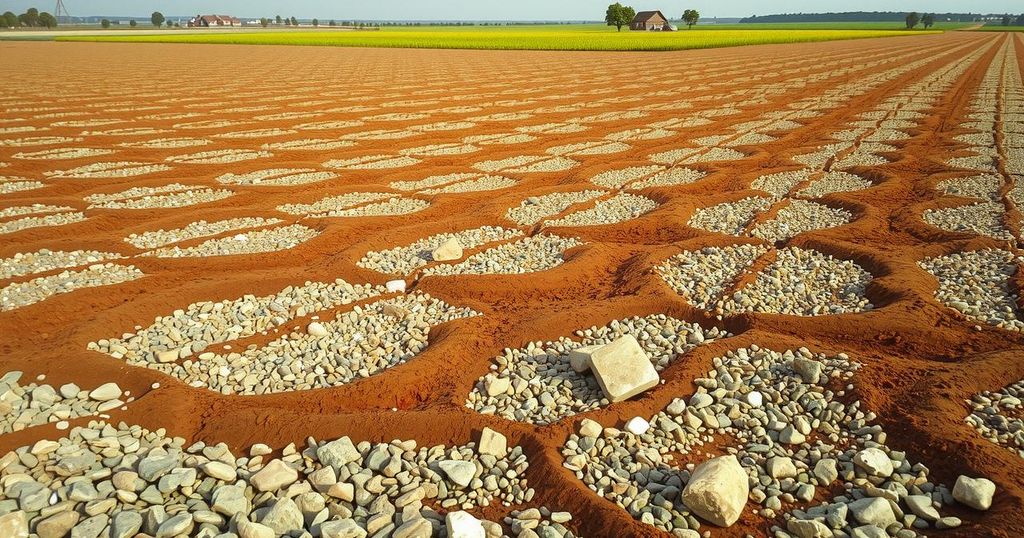Crushed Rock Revolution: A New Approach to Fighting Climate Change
- Crushed rock is used globally on farmlands to combat climate change.
- Enhanced Rock Weathering aims to enhance natural carbon capture processes.
- ERW involves the breakdown of rocks by carbonic acid from carbon dioxide.
- Initial studies show varied effectiveness of ERW in capturing carbon dioxide.
- ERW can improve soil alkalinity and boost crop yields.
- Safety concerns regarding heavy metals in some rocks must be addressed.
- Global projects on ERW are active across multiple continents.
- Investor interest is surging, evidenced by major carbon removal deals.
Crushed Rock’s Role in Climate Change Mitigation
In a striking approach to addressing climate change, crushed rock is being deployed across farmlands globally, ranging from sugar plantations in Brazil to tea estates in India. This innovative technique is known as Enhanced Rock Weathering (ERW). The goal is to fast-track the natural process of capturing and storing carbon dioxide, an infamous greenhouse gas that contributes to global warming.
Understanding Enhanced Rock Weathering
Enhanced Rock Weathering is essentially about turbocharging weathering, which is the natural breakdown of rocks caused by carbonic acid. This acid forms when carbon dioxide from the atmosphere interacts with water. Normally, weathering naturally occurs when rain falls on rocks, where it locks away carbon dioxide as bicarbonate or eventually limestone. By grinding quick-weathering rocks, like basalt, ERW significantly increases their surface area, thus speeding up this natural process. But how effective is this, really?
Evaluating ERW Effectiveness and Limitations
While promising, ERW is still an emerging technology, and there are whispers of doubt regarding how much carbon it can actually extract. One study in the US suggested that applying up to 50 tonnes of basalt per hectare might remove about 10.5 tonnes of carbon dioxide over four years. However, this contrasts with findings from applications in palm oil fields in Malaysia and sugarcane fields in Australia, which reported lower actual carbon removal rates. Factors like the type and size of rock and climate conditions can change everything.
Additional Benefits of Enhanced Rock Weathering
Beyond carbon capture, ERW has other potential benefits. Notably, adding crushed rock can enhance soil alkalinity, leading to increased crop yields and improved soil formation. Plus, basalt is naturally abundant and often available at low costs from quarrying activities. Even when the rock reacts with other acids in soil before locking away carbon dioxide, it still mitigates the acidification that contributes to atmospheric carbon dioxide—essentially preventing carbon release downstream.
Safety Concerns and Measurement Risks
Safety is a considered factor, generally, ERW is regarded as a safe method to accelerate natural processes. However, there is caution regarding certain quick-weathering rocks that may contain high levels of heavy metals that can be toxic. Protective gear is a must for workers handling finely ground rock. The biggest risk, though, is that inaccurate measurements can lead to an overestimation of captured carbon, which becomes significant as some companies are already selling carbon credits based on these projects.
Global Initiatives and Projects for ERW
ERW initiatives are sprouting up across the globe, with projects active in North America, Europe, Latin America, and Asia. A notable project in Brazil recently made headlines as it delivered the first verified carbon-removal credits stemming from an ERW project. Trials are ongoing in agricultural contexts, including tea plantations in India’s Darjeeling and fields of soy and maize in the US, indicating a broad international interest.
Growing Investor Interest in Enhanced Rock Weathering
Investor interest in ERW is picking up steam. Highlighting this trend, an ERW startup called Mati Carbon in India snagged the impressive $50 million X Prize for carbon removal schemes earlier this year. There’s also buzz in the technology sector, as in December, Google finalized a major deal, claiming it was the world’s largest ERW agreement for carbon removal credits, with a hefty number to be delivered by the early 2030s. The business potential is definitely on the rise, although some details about these dealings remain under wraps.
In summary, Enhanced Rock Weathering presents a captivating technique in the fight against climate change, capturing carbon dioxide while potentially improving soil health. While the technology shows promise, its effectiveness varies based on a multitude of factors. As this field continues to develop, further research and refinement will be key to fully realizing its benefits and addressing the risks associated with carbon credit overestimation.




Post Comment